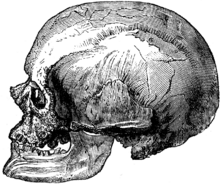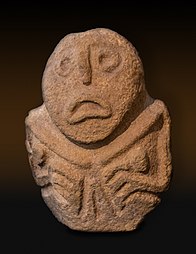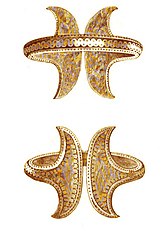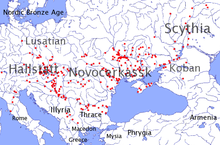Prehistory of Southeastern Europe

The prehistory of Southeastern Europe, defined roughly as the territory of the wider Southeast Europe (including the territories of the modern countries of Albania,
Human
Palaeolithic
- (2,600,000 – 13,000 BP)
Regional Transition to the Upper Paleolithic
- (2,600,000 – 50,000 BP)
The earliest evidence of human occupation discovered in the region, in

There is evidence of human presence in the Southeastern Europe from the Lower Paleolithic onwards, but the number of sites is limited. According to Douglass W. Bailey:[7]
it is important to recognize that the Southeastern Europe Upper Palaeolithic was a long period containing little significant internal change. Thus, regional transition was not as dramatic as in other European regions. Crucial changes that define the earliest emergence of Homo sapiens sapiens are presented at Bacho Kiro at 44,000 BC. The Bulgarian key Palaeolithic caves named Bacho Kiro and Temnata Dupka with early Upper Palaeolithic material correlate that the transition was gradual.
The
In the late Pleistocene, various components of the transition–material culture and environmental features (climate, flora, and fauna) indicate continual change, differing from contemporary points in other parts of Europe. The aforementioned aspects leave some doubt that the term Upper Palaeolithic Revolution is appropriate to the Balkans.
In general, continual evolutionary changes are the first crucial characteristic of the transition to the

During the last interglacial period and the most recent
The notion of gradual transition (or evolution) best defines southeastern Europe from about 50,000 BP. In this sense, the material culture and natural environment of the region of the late Pleistocene and the early Holocene were distinct from other parts of Europe. Douglass W. Bailey writes in Balkan Prehistory: Exclusion, Incorporation and Identity: “Less dramatic changes to climate, flora and fauna resulted in less dramatic adaptive, or reactive, developments in material culture.”
Thus, in speaking about southeastern Europe, many classic conceptions and systematizations of human development during the Palaeolithic (and then by implication the Mesolithic) should not be considered correct in all cases. In this regard, the absence of Upper Palaeolithic cave art in the region does not seem to be surprising. Civilisations develop new and distinctive characteristics as they respond to new challenges in their environment.
Upper Palaeolithic
- (50,000 – 20,000 BP)

In 2002, some of the oldest modern human (
These are some of Europe's oldest remains of
Two human fossil remains found in the Muierii (
The first skull, scapula and tibia remains were found in 1952 in
In 1941 another skull was found at the
The physical analysis of these fossils was begun in the summer of the year 2000 by
The human fossil remains from Muierii Cave, Baia de Fier, have been dated to 30,150 ± 800 years BP, and the skull from the Cioclovina Cave has been dated to 29,000 ± 700 years BP.[14][15][16]
Mesolithic
- (13,000 – 5,000 BP)

The Mesolithic period began at the end of the Pleistocene epoch (10th millennium BC) and ended with the Neolithic introduction of farming, the date of which varied in each geographical region. According to Douglass W. Bailey:[17]
It is equally important to recognize that the Balkan upper Palaeolithic was a long period containing little significant internal change. The Mesolithic may not have existed in the Balkans for the same reasons that cave art and mobiliary art never appeared: the changes in climate and flora and fauna were gradual and not drastic. (…) Furthermore, one of the reasons that we do not distinguish separate industries in the Balkans as Mesolithic is because the lithic industries of the early Holocene were very firmly of a gradually developing late Palaeolithic tradition
The Mesolithic is the transitional period between the Upper Palaeolithic hunter-gathering existence and the development of farming and pottery production during the Postglacial Neolithic. The duration of the classical Palaeolithic, which lasted until about 10,000 years ago, is applicable to Southeastern Europe. It ended with the Mesolithic (duration is two to four millennia) or, where an early Neolithisation was peculiar to, with the Epipalaeolithic.
In regions with limited glacial impact (e.g. Southeastern Europe), the term Epipalaeolithic is preferable. Regions that experienced less environmental impact during the last ice age have a much less apparent and straightforward change, and occasionally are marked by an absence of sites from the Mesolithic era.[17]
There is lithic evidence of the
The single site with materials related to the Mesolithic era in Bulgaria is Pobíti Kámǎni. There has been no other lithic evidence of this period found in Bulgaria. There is a 4,000-year gap between the latest Upper Palaeolithic material (13,600 BP at Témnata Dupka) and the earliest Neolithic evidence presented at Gǎlǎbnik (the beginning of the 7th millennium BC).
At Odmut in Montenegro there is evidence of human activity in the Mesolithic period. The research on the period has been supplemented with Greek Mesolithic finds, well represented by sites such as
Activities began to be concentrated around individual sites where people displayed personal and group identities using various decorations: wearing ornaments and painting their bodies with ochre and hematite. As regards personal identity
The aforementioned allows us to speculate whether or not there was a period which could be described as Mesolithic in Southeastern Europe, rather than an extended Upper Palaeolithic. On the other hand, lack of research in a number of regions, and the fact that many of the sites were close to seashores (It is evident that the current sea level is 100 m higher, and a number of sites were covered by water.) means that the Mesolithic Southeastern Europe could be referred to as the Epipalaeolithic Southeastern Europe, which might describe better its gradual changes and poorly defined development.
The relative climatic stability in Southeastern Europe, compared to northern and western Europe, enabled continuous settlement in Southeastern Europe. Southeastern Europe therefore may have effectively functioned as an ice-age refuge from which much of Europe, especially eastern Europe, was re-populated.
Neolithic

Southeastern Europe was the site of major Neolithic cultures, including Butmir, Vinča, Varna, Karanovo, Hamangia and Sesklo.
The
The Varna Necropolis, Bulgaria, is a burial site in the western industrial zone of Varna (approximately 4 km from the city centre), internationally considered one of the key archaeological sites in world prehistory. The oldest gold treasure in the world, dating from 4,600 BC to 4,200 BC, was discovered at the site.[18] The gold piece dating from 4,500 BC, recently founded in Durankulak, near Varna is another important example. [19][20][21][22]
"
Neolithic settlements are also spotted in modern day Greece, trading routes that are based in the late Mesolithic period exist all over the Aegean sea. Some major settlements of
- Butmir culture
- Starčevo-Criş culture
- Dudeşti culture
- Cucuteni-Trypillian culture
- Hamangia culture
- Vinča culture
- Varna culture
- Tărtăria tablets
- Kurgan hypothesis
Bronze Age


- (3,500 – 1,100 BCE)
The Bronze Age in Southeastern Europe is divided as follows (Boardman p. 166):
- Early Bronze Age: 20th to 16th centuries BCE
- Middle Bronze Age: 16th to 14th centuries BCE
- Late Bronze Age: 14th to 13th centuries BCE
The Bronze Age in the central and eastern part of Southeastern Europe begins late, around 1800 BCE. The
The "East Balkan Complex" (Karanovo VII,
The Minoan civilization based on the Greek island of Crete becomes Europe's first actual civilization.
The culture of Mycenaean Greece (1600-1100 BC) offers the first written evidence of the Greek language.[23] Several Mycenaean attributes and achievements were borrowed or held in high regard in later periods.[23] while their religion already included several deities that can also be found in the Olympic Pantheon. Mycenaean Greece was dominated by a warrior elite society and consisted of a network of palace states.[23] It was followed by the Greek Dark Ages and the introduction of iron.
Iron Age

- (1,100 BCE – 150 CE)
After the period that followed the arrival of the
Other notable groups of peoples and tribes of Southeast Europe organised themselves in large tribal unions such as the
The
Other tribal unions existed in Dacia at least as early as the beginning of the 2nd century BC under King Oroles. In the beginning of 1st century BC under Burebista's rule, Dacia expanded its territory from Central Europe to the Southern Europe.
See also
- Aegean civilization
- History of Eurasia
- History of Europe
- Lists of ancient tribes in the Balkans
- Old European culture
- Paleo-Balkan languages
- Paleolithic Europe
- Bronze Age in Romania
- Prehistoric Croatia
- Prehistoric Europe
- History of Albania
- Prehistory
- Proto-Indo-Europeans
- Timeline of glaciation
- Slavic migrations to Southeastern Europe
References
- Inline
- ^ Professor Shelmerdine's Exciting Mycenaean Find, UT Austin Jun 2, 2011.
- ^ E. Hallager, M. Vlasakis, and B. P. Hallager, "The First Linear B Tablet(s) from Khania", Kadmos, 29 (1990). pp. 24–34
- ^ Wren, Linnea Holmer; Wren, David J.; Carter, Janine M. (1987). Perspectives on Western Art: Source Documents and Readings from the Ancient Near East Through the Middle Ages. Harper & Row. p. 55. ISBN 978-0-06-438942-6.
- ^ https://www.google.com/search?tbo=p&tbm=bks&q=Protohistoric+Greece+bronze+Age [bare URL]
- ^ e.g. Thrace in book V.
- ^ "Sirakov et al. (2010).- an ancient continuous human presence in the Balkans and the beginnings of human settlement in western Eurasia: A Lower Pleistocene example of the Lower Palaeolithic levels in Kozarnika cave (North-western Bulgaria) | Philippe Fernandez - Academia.edu". Archived from the original on 2014-12-25. Retrieved 2017-12-04.
- ISBN 0-415-21597-8
- ^ Trinkaus, E., Milota, Ş., Rodrigo, R., Gherase, M., Moldovan, O. (2003), Early Modern Human Cranial remains from the Peştera cu Oase, Romania in Journal of Human Evolution, 45, pp. 245 –253, [1]
- ^ João Zilhão, (2006), Neanderthals and Moderns Mixed and It Matters, in Evolutionary Anthropology, 15:183–195, p.185
- ^ Trinkaus, E., Moldovan, O., Milota, Ş., Bîlgăr, A., Sarcina, L., Athreya, S., Bailey, S.E., Rodrigo, R., Gherase, M., Hilgham, T., Bronk Ramsey, C., & Van Der Plicht, J. ( 2003), An early modern human from Peştera cu Oase, Romania. Proceedings of the National Acadademy of Science U.S.A., 100(20), pp. 11231–11236
- ^ Andrei Soficaru, Adrian Dobo and Erik Trinkaus (2006), Early modern humans from the Peştera Muierii, Baia de Fier, Romania, Proceedings of the National Acadademy of Science U.S.A., 103(46), pp. 17196-17201
- ^ Harvati K, Gunz P, Grigorescu D. Cioclovina (Romania): affinities of an early modern European. J Hum Evol. 2007 Dec;53(6):732-46
- ^ "Dating Bulletin". 2008-04-11. Archived from the original on 11 April 2008. Retrieved 2022-03-18.
- ^ Olariu A., Alexandrescu E., Skog G., Hellborg R., Stenström K., Faarinen M. and Persson P, Dating of two Palaeolithic human fossil bones from Romania by accelerator mass spectrometry, NIPNE Scientific Reports 2001-202, pag. 82
- ^ Olariu A., Skog G., Hellborg R., Stenström K., Faarinen M. and Persson P. and Alexandrescu E., 2003, Dating of two Palaeolithic human fossil bones from Romania by accelerator mass spectrometry, http://arXiv.org/abs/physics/0309110 Archived 2022-06-08 at the Wayback Machine
- ISBN 973-27-1181-7, Dating of two Palaeolithic human fossil bones from Romania by accelerator mass spectrometry, 235-239
- ^ a b Balkan prehistory
Page 36 Archived 2023-01-15 at the ISBN 0-415-21597-8
- ^ [2] Archived 2023-01-15 at the Wayback Machine Gems and Gemstones: Timeless Natural Beauty of the Mineral World, By Lance Grande
- ^ (https://www.smithsonianmag.com/travel/varna-bulgaria-gold-graves-social-hierarchy-prehistoric-archaelogy-smithsonian-journeys-travel-quarterly-180958733/)
- ^ (http://archaeologyinbulgaria.com/2015/10/15/bulgaria-showcases-worlds-oldest-gold-varna-chalcolithic-necropolis-treasure-in-european-parliament-in-brussels/)
- ^ (https://www.smithsonianmag.com/smart-news/oldest-gold-object-unearthed-bulgaria-180960093/)
- ^ (https://europost.eu/en/a/view/world-s-oldest-gold-24581 Archived 2019-09-28 at the Wayback Machine)
- ^ ISBN 0-415-36336-5. Archivedfrom the original on 2023-01-15. Retrieved 2018-02-23.
- ^ The Illyrians. John Wilkes
- General
- John Boardman, The Cambridge Ancient History, Part I: The Prehistory of the Balkans to 1000 BC, Cambridge University Press (1923), ISBN 0-521-22496-9.
- Douglass W. Bailey, Balkan prehistory, ISBN 0-415-21597-8
- Alexandru Păunescu, Evoluţia istorică pe teritoriul României din paleolitic până la inceputul Neoliticului, SCIVA, 31, 1980, 4, p. 519-545.
- Paul Lachlan MacKendrick, The Dacian Stones Speak, The University of North Carolina Press, Chapel Hill, 1974, ISBN 0-8078-4939-1
External links
- Periodization of Balkan Prehistory ~ 6200 - 1100 BC
- South East Europe pre-history summary to 700BC Archived 2010-08-04 at the Wayback Machine
- Balkan Prehistory: Exclusion, Incorporation and Identity by Douglass W. Bailey
- The Aegeo-Balkan Prehistory Project
- (in Romanian) Ion din Anina, primul om din Europa Archived 2014-07-20 at the Wayback Machine on Jurnalul.ro
- (in English) Human fossils set European record on BBC.co.uk
- (in Romanian) Enciclopedia României
